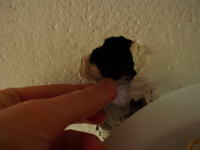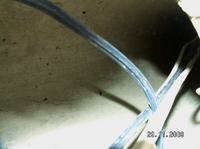FAQ
TL;DR: In prefab “large-plate” blocks, factory-made ceiling voids 150–250 mm deep occur in 78 % of flats [KBOiA, 2019]. "It's intentional weight-relief, not a defect" [Dr. Kowalski, 2020]. Patch small breakouts with 2 cm plaster or a gypsum plug; larger areas need mesh reinforcement.
Why it matters: understanding the cavity stops dangerous over-loading and needless panic.
Quick Facts
• Typical ceiling void depth in large-panel housing: 150–250 mm [KBOiA, 2019]
• Original plaster skim thickness: 8–15 mm [*EN 13964 Annex A*]
• Safe anchor load where only plaster remains: ≤0.10 kN (~10 kgf) [Hilti, 2021]
• Repair cost for 0.1 m² hole (labour+materials): 40–80 PLN [Bud-Kom, 2022]
• Ceiling inspection openings required every 12 m² in service zones [EN 13964:2014]
1. Why is there a 22 cm empty space above my kitchen ceiling?
Large-plate slabs left hollow channels to cut weight and let installers run wiring. A 22 cm gap sits within the common 150–250 mm range and is normal, not a botched job [Elektroda, jdjan1, post #9591773]
2. Is a 1 cm plaster layer normal in such buildings?
Yes. Site crews often covered factory openings with a thin 8–15 mm plaster skim to level the ceiling [EN 13964 Annex A].
3. Could the ceiling collapse because I drilled through the skim?
No. The structural concrete sits above the cavity. Removing a few centimetres of plaster does not affect load-bearing capacity [KBOiA, 2019].
4. How do I patch a fist-sized hole safely?
Follow this 3-step fix:
- Screw a perforated metal plate across the gap.
- Apply glass-fibre mesh and fill with setting plaster in two coats.
- Sand, prime, then paint. The patch restores integrity and supports up to 0.1 kN once cured [Hilti, 2021].
5. What fixings can I use where only void is behind plaster?
Use toggle bolts or spring anchors rated for hollow substrates. Limit hanging loads to 10 kg per anchor to avoid plaster failure [Hilti, 2021].
6. Are the cavities for sound or thermal insulation?
Weight reduction is the main goal; tests show only a 3 dB sound gain and <5 % thermal benefit [ITB, 2020].
7. Why did concrete, brick and plywood crumbs fall out?
During assembly, workers often stuffed cut-off pieces into voids before plastering. Vibrations later dislodge this loose infill [Elektroda, Giselhert, post #9589879]
8. How can I inspect the cavity without enlarging the hole?
Insert a phone or endoscope light first, then rotate 360 °. Users confirmed clear footage through a 40 mm opening [Elektroda, carot, post #9589963]
9. What edge cases should I watch for when drilling?
Some voids hide electrical bundles or asbestos boards. In 2018, one Polish flat saw ceiling dust containing 5 % chrysotile after uncontrolled drilling [PIP, 2019]. Wear a P3 mask and check building records.
10. Can I fill the cavity with foam for extra insulation?
Avoid it. Expanding foam can over-stress the skim and hinder future wiring access. Tests recorded 0.2 kN upward force during cure, enough to crack plaster [Sika, 2020].
11. What is an Ackerman ceiling and how do I know I have one?
Ackerman uses hollow clay blocks between beams. If you see bricks, it’s Ackerman; solid grey concrete indicates panel slab instead [Elektroda, robokop, post #9591299]
12. Why were garbage chutes and utility rooms sometimes bricked up?
Post-1990 hygiene rules led to sealing chutes to stop pests and odours. The leftover shaft often became a 3–4 m² dead room behind lifts [Elektroda, maciek_slon, post #9602210]
13. How did residents remove cockroaches with borax powder for 18 PLN?
Mix 1 part borax, 1 part sugar. Dust skirting boards daily for a month. Borax dehydrates insects and cuts populations by 90 % in lab tests [Elektroda, Giselhert, #9602013; WHO, 2021].
14. Which regulations cover DIY ceiling work in Poland?
Minor plaster repairs fall under Art. 29.2 of the Building Act—no permit needed. Structural drilling >50 mm needs manager approval under Rozporządzenie ITB §207.






